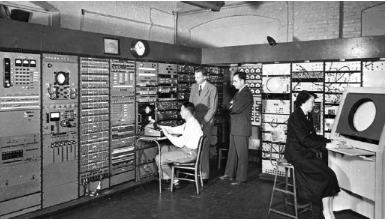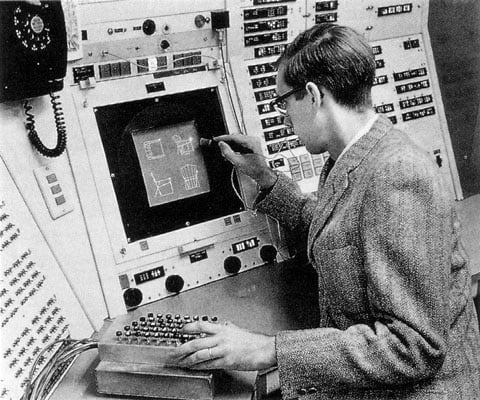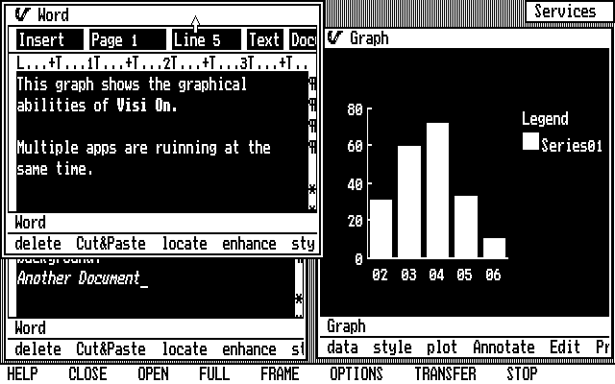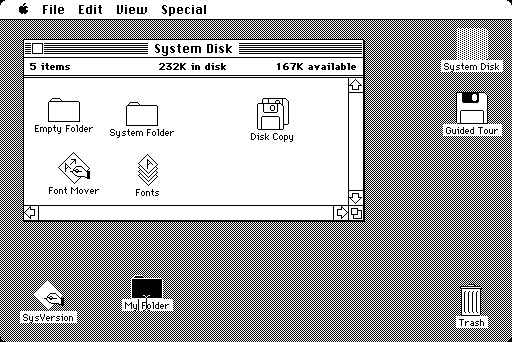

When thinking of computer graphics people will commonly imagine the high definition 3D models used in todays video games or even movies that look incredibly realistic its enough to trigger the uncanny valley phenomena. Computer graphics have come a long way in such a short amount of time and its really only been about 60 years since computer graphics were being actively improved and worked on. The first “graphics” started as punched cards. These were what were used to visually display information and it wasn’t even displayed on the computer screen. The computer would take the punch cards and read them, loading in the information.
The way we see computer graphics now kicked off with the invention of an Oscilloscope. This is a machine that shows voltage data as waves. Ben Laposky was the one who created the connection between using an oscilloscope as computer graphics leading him to become one of the first computer artists. He saw the potential in having a visual representation of the data displayed on the screen. Ben Laposky himself said, “The relationship of the oscillons to computer art is that the basic waveforms are analogue curves, of the type used in analogue computer systems.” Laposky’s genius idea allowed him to set the stage for future computer graphic designers and started a chain reaction of the need to represent visual data on computers in an easy, readable way.
A few years later in what started as a flight simulation project, came the Whirlwind project. The idea originally started because the Navy asked MIT to make an analog computing system to be used during training. After Jay Forrester, who was working on this assignment at MIT, saw the ENIAC, the whole project converted into trying to create a digital computer. The team then had to figure out how to make the computer work in real time Forrester had the brilliant idea to use magnetic cores with three dimensional arrays allowing the machine to run properly. This was the first computer to have a visual display that actually was able to work in real time.

The Whirlwind Project also produced a light pen. This was another form of technology that would assist in designing the graphics of computers to come. This was an input device that could be used to draw or select specific points on the screen. In the case of the whirlwind project, which was being used for a Navy flight simulator the pen could be pointed at the screen to select a plane, and then the information about that plane would be sent back and shown on the computer. This technology may have been replaced by the mouse for many years, but we’ve seen this resurface with the rise of touch screen tech. The stylus is a very similar modern reinvention of a light pen.
In 1963, a major breakthrough in computer design happened when Ivan Sutherland created Sketchpad, an interactive program that you could use to draw. This application used the technology of oscilloscopes and the light pen to birth what has become known as the first CAD (computer aided design) system. This program was actually very ahead of its time. It allowed the user to directly draw on the screen and allowed you to take the images or segments drawn and copy them so they could be used again. It would also connect lines automatically at endpoints. The program also implemented tools so the drawing could be modified because it included 17 different types of constraints, including vertical, horizontal, perpendicular, coincident, parallel, aligned, equal size, and more” (Yares). This let the drawing be edited and moved around to get the shapes wanted. The drawing could also be rotated and stretched allowing for even further manipulation of the shape or drawing. Sketchpad was the blueprint for many drawing programs used today like MS Paint or even photoshop.

Throughout the 60s and into the 70s computer graphics and design became very popular and tons of new companies based on making computer graphics and selling graphics equipment were starting up. This was mostly due to the growth of software and more user-friendly options for computers being produced such as the mouse and keyboard. Touch sensitive devices also were created. Computers at this time were still seen as something only used by companies or for professional usage, but revenue from selling graphic hardware and software was still spiking. Computer graphics at this time was making the shift from being used for aircraft training and textile industries to become used for design and entertainment.
In the 70s two-dimensional graphics were on the rise being used for arcade games. Raster graphics had just been invented and lead to the development of video games. Raster graphics used pixels on a screen to map out colors in a grid-like formation. Pictures could be displayed on a computer screen by mapping it out in pixels. Each pixel would contain bits of information to display the correct color. The number of pixels in an image would be called the resolution and this would be the number of columns by rows. Pong was the first game released using 2d graphics that would eventually be commercially produced for tons of people to play. Pong used raster display to depict to rectangular paddles to hit a ball back and forth. This influenced the creation of many more arcade games and started the video game craze that is still occurring today.

In 1977 the Apple II personal computer was released to the public and led to more people purchasing personal computers for their homes. This computer supported graphics and the display was in color. Steve Wozniak managed to create a high-resolution mode where instead of using one pixel, he could use two pixels in a block to create two more colors than if just a single pixel was used. This was a very interesting and difficult trick at the time but led to a very impressive result. The computer also had a low-resolution mode without the block of pixels used, and therefore less color as a result.
Three-dimensional graphic design was introduced with the invention of a 3D CAD program called CATIA made by Francis Bernard. Although this wasn’t the only one at this time this was one of the most notable. With the invention of this software more realistic renderings of objects could be created. Designs could now be more detailed and accurate compared to the two-dimensional renderings that were the only possible result prior. Being able to design in three-dimensions made things easier for many professional careers like architecture, as well as just made things created for entertainment purposes look better. This technology was a huge improvement over hand drawn or basic two-dimensional design. Nowadays we see 3D design everywhere in movies, video games, animation, etc. 3D design hasn’t completely replaced 2D design but it definitely has a bigger impact on todays society than 2D design has in a long time.
Around this time GUI’s or graphical user interfaces were being designed for personal computers as well. GUIs are probably one of the most important factors of designing a personal computer. The GUI could make or break the success of the PC. It impacts the usability and how efficiently the user can use of the GUI to get their tasks done. It is the visual display of the components of the computer. The first GUI was created by Xerox however this was not meant for everyday uses as it just used for research at universities. Then VisiCorp produced a GUI for the IBM PC and this GUI actually used a mouse and was used in businesses. The Mac OS System 1.0 had the first GUI that looked and worked like a modern-day GUI. It used a mouse to interact with icons and windows that could be dragged and copied. This GUI set the precedent for all GUI’s built after it.


Computer graphics can not be fully discussed without talking about graphics cards. In the 80s, before graphics cards there were video display cards. IBM made the first one with the invention of the Monochrome Display Adapter which allowed for high resolution display of text but not any sort of graphics. Soon after IBM created the first graphic card which allowed for full color display. After this tech companies were creating their own graphic cards to try to one up the rest. Soon the first graphics card allowing for 3D graphics was invented with the 3dfx Voodoo graphics chip. Soon the term GPU (Graphics Processing Unit) was coined and hundreds of graphic cards were produced. Today, GPU’s are an integral part of every computer especially in those who value gaming.
Entering the 21st century graphics have taken a crazy turn. Humans are now constantly using computer graphics in everyday life to make improvements and to up the quality of living. Computer graphics are used in movies to make realistic battle scenes or in video games to make realistic characters and story lines. Computer graphics are also being used in the science fields to analyze and predict things about our environment, space, and health issues. There is no doubt that humanity has come such a long way in a very short time when it comes to computer graphics when we started at punch cards and are now using virtual reality. New technology is still being developed that will take graphics even further than can be imagined.
“Ben F. Laposky | Database of Digital Art.” Compart, dada.compart-bremen.de/item/agent/253. Accessed 19 Jan. 2021.
Gyorgy. “Operating System Interface Design Between 1981-2009.” Webdesigner Depot, 7 Feb. 2018, www.webdesignerdepot.com/2009/03/operating-system-interface-design-between-1981-2009.
“Jay W. Forrester’s Project Whirlwind : History of Information.” History of Information, www.historyofinformation.com/detail.php?id=633. Accessed 19 Jan. 2021.
Machover, Carl. "A Brief, Personal History of Computer Graphics." IEEE Computer 11.11 (1978): 38-45.
Magazine, Paleotronic. “Colour Without Colour: Apple II Computer Graphics.” Paleotronic Magazine, 5 Oct. 2018, paleotronic.com/2018/10/03/apple-ii-colour-computer-graphics.
Marschner, Steve, and Peter Shirley. Fundamentals of computer graphics. CRC Press, 2015.
Pc, Xotic. “History of GPUs.” XOTIC PC, xoticpc.com/blogs/news/history-of-gpus. Accessed 19 Jan. 2021.
“Project Whirlwind | The MIT 150 Exhibition.” Museum MIT, museum.mit.edu/150/21. Accessed 19 Jan. 2021.
“Section 2: The Emergence of Computer Graphics.” Wayback Machine, web.archive.org/web/20090505031418/http://design.osu.edu/carlson/history/lesson2.html. Accessed 19 Jan. 2021.
The Editors of Encyclopaedia Britannica. “Raster Graphics | Computer Science.” Encyclopedia Britannica, www.britannica.com/technology/raster-graphics. Accessed 19 Jan. 2021.
Tucker, Neal. “The Evolution of 3D CAD Design and Drafting | Cad Crowd.” Cad Crowd, 16 July 2019, www.cadcrowd.com/blog/the-evolution-of-3d-cad-design.
Yares, Evan. “50 Years of CAD.” Design World, 29 Oct. 2019, www.designworldonline.com/50-years-of-cad.